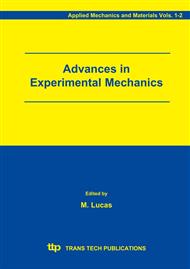p.159
p.165
p.171
p.179
p.185
p.191
p.197
p.205
p.211
Detecting Damage in Graphite/Epoxy Composites Using Impedance-Based Structural Health Monitoring
Abstract:
The impedance-based structural health monitoring method is used to successfully detect different damage mechanisms in composites and to correlate the changes in impedance measurements with the changes in the structure. Specifically, graphite/epoxy composite samples are manufactured and tested. Piezoceramic (PZT) patches are attached to the composite coupons to actuate the structure with high-frequency excitations. Bonding the patches to the sample allows changes in the structural mechanical impedance to be monitored with the electrical impedance of the PZT. Samples are tested using quasi-static tensile loading to introduce damage. To determine the extent of damage incurred, impedance signatures are acquired before and after the tensile load is applied. A change in impedance from the baseline shows the presence of damage. The amount of damage is characterized using a damage metric. Radiography is used to verify the extent of damage.
Info:
Periodical:
Pages:
185-190
Citation:
Online since:
September 2004
Authors:
Price:
Сopyright:
© 2004 Trans Tech Publications Ltd. All Rights Reserved
Share:
Citation:


